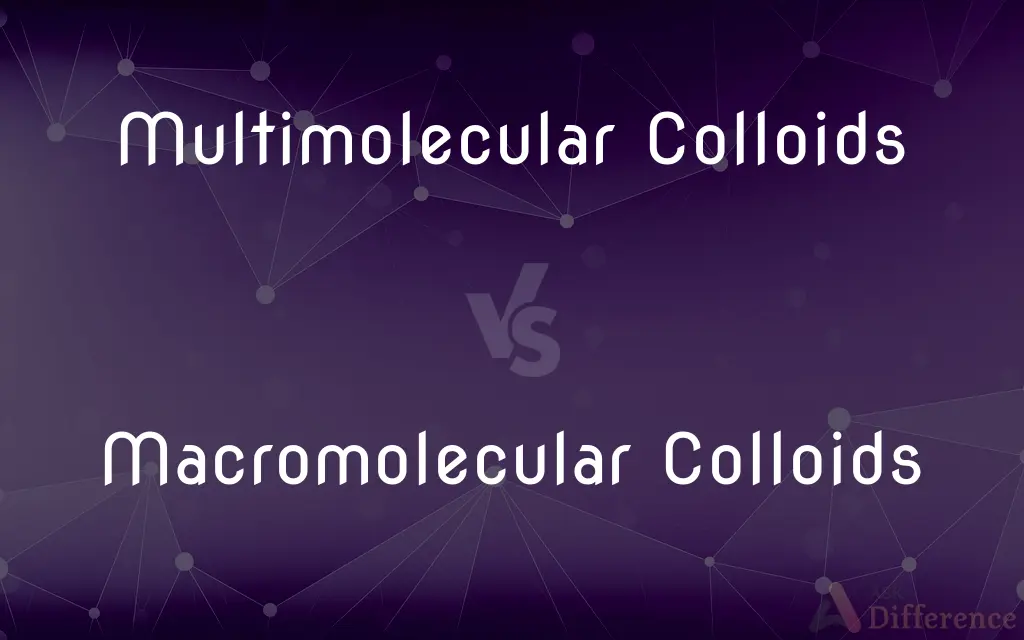Multimolecular Colloids vs. Macromolecular Colloids — What's the Difference?
By Tayyaba Rehman — Published on January 6, 2024
Multimolecular Colloids are aggregates of smaller particles; Macromolecular Colloids are large molecules dispersed in a medium.

Difference Between Multimolecular Colloids and Macromolecular Colloids
Table of Contents
ADVERTISEMENT
Key Differences
Multimolecular Colloids consist of aggregates or clusters of smaller molecules or particles that come together to form a size range typical of colloids. On the contrary, Macromolecular Colloids have their colloidal size due to the inherent large size of individual molecules.
In the realm of colloidal science, Multimolecular Colloids often result from the accumulation of atoms or small molecules. Gold sol is an example where tiny gold particles aggregate to form this type of colloid. Meanwhile, Macromolecular Colloids arise from single, giant molecules like polymers or proteins dispersing in a solvent.
One of the key differences between Multimolecular Colloids and Macromolecular Colloids lies in their formation. While the former results from external forces or conditions making small particles come together, the latter involves the dispersion of naturally large molecules in a medium.
Understanding the behavior of Multimolecular Colloids often requires studying how individual particles interact and aggregate under various conditions. On the other hand, studying Macromolecular Colloids usually delves into how large molecules like proteins or polymers interact with solvents or other molecules.
In applications, Multimolecular Colloids might be used where the properties of aggregated particles are beneficial, such as in certain catalysts. In contrast, Macromolecular Colloids, due to their large molecular size, are prevalent in areas like polymer science and biochemistry.
ADVERTISEMENT
Comparison Chart
Basic Composition
Aggregates of smaller particles
Large molecules dispersed
Example
Gold sol
Proteins in water
Formation Basis
Accumulation of small particles
Dispersion of inherently large molecules
Study Focus
Particle aggregation
Interaction of large molecules with solvents
Typical Applications
Catalysts
Polymer science, biochemistry
Compare with Definitions
Multimolecular Colloids
Behave as a single entity despite being made of smaller units.
Multimolecular Colloids in certain suspensions act as single particles when exposed to light.
Macromolecular Colloids
Colloids formed from inherently large molecules.
Starch dispersed in water forms Macromolecular Colloids.
Multimolecular Colloids
Formed when smaller particles come together to reach colloidal size.
Some metallic sols are Multimolecular Colloids due to atom accumulation.
Macromolecular Colloids
Do not rely on aggregation for their colloidal size.
A protein in a solution remains a Macromolecular Colloid without needing to aggregate.
Multimolecular Colloids
Often reversible, can be broken down to constituent particles.
Applying heat can sometimes disperse Multimolecular Colloids back to smaller units.
Macromolecular Colloids
Common in biochemistry and polymer science.
The dispersion of DNA in certain buffers results in Macromolecular Colloids.
Multimolecular Colloids
Aggregates formed from smaller molecules or particles.
Gold sol is a result of gold atoms aggregating to form Multimolecular Colloids.
Macromolecular Colloids
Interactions with solvents are crucial for their behavior.
The solubility of Macromolecular Colloids like cellulose depends on its interaction with the solvent.
Multimolecular Colloids
Size is due to external forces or conditions causing aggregation.
By altering pH, some solutions can be made to form Multimolecular Colloids.
Macromolecular Colloids
Individual molecules are of colloidal dimensions.
Enzymes in a solution act as Macromolecular Colloids.
Common Curiosities
How do Multimolecular Colloids form?
They result from external forces making smaller particles aggregate.
What's a common Macromolecular Colloid in biochemistry?
Proteins dispersed in water act as Macromolecular Colloids.
How do Macromolecular Colloids differ from Multimolecular Colloids?
Macromolecular Colloids are formed from large molecules, while Multimolecular are aggregates of smaller ones.
Why are polymers often considered Macromolecular Colloids?
Their individual molecules are inherently large and of colloidal dimensions.
What are Multimolecular Colloids?
They are colloids formed from aggregates of smaller particles.
Do Multimolecular Colloids have applications in industry?
Yes, they're used in areas like catalysis.
Can you give an example of a Multimolecular Colloid?
Gold sol, formed by the accumulation of gold atoms, is an example.
Do Multimolecular Colloids always remain stable?
No, changes in conditions can disperse them back to smaller units.
Are all aggregates in solutions Multimolecular Colloids?
No, only those that achieve a colloidal size range.
How does temperature affect Macromolecular Colloids?
It can impact their solubility and interactions with the solvent.
Between Multimolecular and Macromolecular Colloids, which is more common in nature?
Both are common, but Macromolecular Colloids are especially prevalent in biological systems.
Can Multimolecular Colloids be seen with the naked eye?
No, their size is typically beyond direct visual observation, though their effects might be seen.
What determines the behavior of Macromolecular Colloids in solutions?
Their interaction with the solvent is crucial.
Why is studying Macromolecular Colloids important in medicine?
They help in understanding drug delivery and biological interactions.
Can you give another example of a Macromolecular Colloid?
DNA dispersed in certain buffers forms this type of colloid.
Share Your Discovery

Previous Comparison
Gingelly Oil vs. Sesame Oil
Next Comparison
RPC vs. RMIAuthor Spotlight
Written by
Tayyaba RehmanTayyaba Rehman is a distinguished writer, currently serving as a primary contributor to askdifference.com. As a researcher in semantics and etymology, Tayyaba's passion for the complexity of languages and their distinctions has found a perfect home on the platform. Tayyaba delves into the intricacies of language, distinguishing between commonly confused words and phrases, thereby providing clarity for readers worldwide.













































